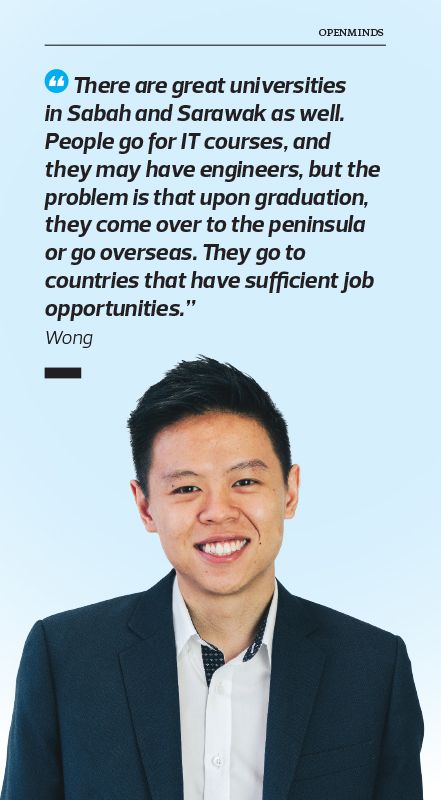This article first appeared in Digital Edge, The Edge Malaysia Weekly on January 27, 2025 - February 2, 2025
In Malaysia, the discourse on digitalisation often revolves around three key regions — Kuala Lumpur, Penang and Johor — all located in the peninsula. Meanwhile, Sabah and Sarawak, with their growing talent pools and untapped potential, risk being left behind unless deliberate efforts are made to harness their capabilities.
If opportunities continue to be concentrated in the peninsula despite the increasing accessibility of advanced technologies, the divide between Peninsular Malaysia and Sabah and Sarawak will only widen.
Jan Wong, founder and online strategist at OpenMinds Sdn Bhd, is determined to change this narrative. He believes that the key to bridging this gap, quickly and sustainably, lies in creating opportunities for tech talent in Sabah and Sarawak to address the persistent brain drain in the two states.
“The problem is how [those in Sabah and Sarawak] can utilise all this technology. Are companies opening up jobs for them to practise these skill sets and competencies?” says Wong.
With limited access and opportunities, talented individuals from Sabah or Sarawak might attend numerous artificial intelligence (AI) courses. But without jobs or platforms to apply those skills, their potential goes untapped. This represents a significant loss of talent.
A parallel can be drawn from within Peninsular Malaysia itself. For instance, much of the tech talent was previously concentrated in the Klang Valley. However, with the emergence of data centres and other tech-related opportunities in Johor, more local talent now choose to remain in the state, reversing the outflow and fostering regional growth, he points out.
“There are great universities [in Sabah and Sarawak] as well. People go for IT courses, and they may have engineers, but the problem is that upon graduation, they come over to the peninsula or go overseas. They go to countries that have sufficient job opportunities,” says Wong.
He explains that in Sabah and Sarawak, most engineers who remain there are employed in the oil and gas sector. Meanwhile, AI engineers and other tech experts educated in the two states often leave in search of better opportunities elsewhere, perpetuating a cycle that leaves Sabah and Sarawak back at square one.
OpenMinds’ subsidiary, OpenAcademy, conducts education programmes aimed at supporting small and medium enterprises (SMEs). Recently, it started emphasising talents in Sabah and Sarawak to bridge the digital divide. It was by engaging directly with SMEs there that Wong gained valuable insights into their challenges and pain points.
What he discovered was a striking disparity in technological adoption between Peninsular Malaysia and Sabah and Sarawak. Tools and processes that are commonplace in the peninsula — such as leveraging social media for marketing — are unfamiliar to many businesses in the two Borneo states, highlighting the urgent need for targeted digitalisation efforts.
“Some of the questions that SME operators who attend some of our programmes ask us are very elementary things, like ‘How do I use Instagram to run a business?’ or ‘How do I even go about setting up a Shopee store?’” says Wong.
These experiences led him to realise how much businesses in the peninsula take digitalisation for granted. Using AI as an example, he highlights one of its greatest advantages — accessibility. However, he notes that the accessibility is limited to the tech-literate generation, leaving those without the necessary skills or exposure unable to benefit from its potential.
“We are used to processes, we have systems in place, we have apps and cloud-based systems all set up. Therefore, it is easier for us to access. Now take the same conditions and implement them in Sabah and Sarawak, which are still facing fundamental challenges,” says Wong.
“If digital marketing is still something the locals sometimes struggle with and are trying to convince their bosses to spend more money on advertising or developing it properly, AI is still a little out of reach.”
Addressing the talent and information gap
OpenAcademy’s courses are currently focused on introducing marketing technology trends to companies unaware of their value, aiming to create opportunities for local businesses while driving growth for OpenMinds itself.
A crucial part of bridging the digital gap is understanding the local market, Wong believes. He observes that when companies from the peninsula enter Sabah and Sarawak, they often encounter reservations from the local community. This is frequently due to a common oversight: failing to appreciate and adapt to the customs and cultures unique to the two states.
“You [can] say how business is done and, to be honest, there is some level of difference. That’s why I believe, when a company approaches a new market, the first approach is usually to provide direct value to the community first. That’s why we feel that education is a way forward. Bring in expertise, bring in help, bring in value,” he says.
Raising awareness of reskilling and upskilling comes with its own set of challenges, one of which Wong identifies as leadership limitations. Similar to Peninsular Malaysia, there are companies in Sabah and Sarawak that have been operating for 30 years or more — and are often set in their ways. Coupled with a less digitalised culture in the two states, the journey toward transformation becomes even steeper.
OpenAcademy is in talks with local universities to form partnerships with their courses so they can offer accredited certificates for completing their courses as well as giving universities in Sabah and Sarawak a more tangible influence on the industry.
“This matter is very popular here in the peninsula. Every university has something like that. But we’re trying to introduce this into local universities in Sabah and Sarawak as well, so that we will be able to work with them on developing modules that are even better for the students,” says Wong.
OpenMinds provides diagnostic tools for SMEs to assess their digitalisation readiness and information on where they can get resources and free consultancy sessions to move forward in their digital transformation journey.
“We only managed to make more obvious progress in the past six months or so. The first year was challenging, where it was even difficult to find partners to talk with. Or if we did find partners, they were eager to [talk] but not eager to take action,” he says.
Wong attributes this recent progress to taking the time needed to understand and address what the locals really needed instead of directly bringing in what is trending in the peninsula, which they may not understand or see the value of, given how different the cultures are.
The main challenge and cause of this technology gap is connectivity. Sabah and Sarawak are the largest states in the country and take up more land than the peninsula, at 198,447 sq km versus 132,490 sq km respectively, with cities and towns spaced out more. Something that can only be rectified with increased infrastructure.
“There are always years of lag [in technological trends] in Sabah and Sarawak, and this is usually attributed to connectivity,” says Wong.
Bringing relevant resources to Sabah and Sarawak
Wong says that despite all these efforts, bridging the gap needs to be a country-wide effort. Those in the peninsula should not see Sabah and Sarawak as separate markets but as a new market with its own talents and potential.
“These private companies [could] extend their presence and bring their expertise to Sabah and Sarawak, instead of just focusing on one part, setting up something over there to engage the workforce, engage the people, so they not only learn but also have the opportunity to engage the jobs directly where they’re at,” he says.
However, a key issue OpenMinds and every other company from Peninsular Malaysia face when going into Sabah and Sarawak is access to the relevant resources to even enter the states.
“The interesting thing about this particular situation is that a lot of companies, or private companies in the [peninsula], are thinking about Sabah and Sarawak but have no way in,” says Wong.
“They have no idea what the right platform is to go in, what the right angle is so they can position themselves, who they should speak to or who the right parties are to actually work with over there. There is somehow a disconnect, even in simple business terms.”
There is a lack of easily accessible resources on who businesses from Peninsular Malaysia should even collaborate with, if there is even an official governmental body they should approach, or if agencies like Malaysia Digital Economy Corporation have a presence there.
Wong notes that the resources available are so limited that it becomes difficult to even start a conversation.
“I’ve seen the government doing some level of events, conferences … the Human Resource Development Corporation recently did something over there to promote jobs. But if you ask me whether it’s enough or if it’s comparable to what’s being done in the peninsula, probably not,” he says.
Beyond government initiatives and training centres like OpenAcademy, Wong has seen other businesses try to reach out and close this digital gap between Peninsular Malaysia and Sabah and Sarawak, like more co-working space providers setting up branches there. He is hopeful that as more attention is put on the states in the peninsula, more tech-related opportunities will spill over to the two Borneo states.
“What we really hope to see is that it will no longer be the case where we always need to bring trends into Sabah and Sarawak. I think that milestone will be very obvious. When we see the trends are adopted equally and the difference is probably just the implementation,” he says.
“Because right now, the issue is that companies are bringing in trends and telling them: ‘Hey, this is what they are doing. This is how we’re doing it over there.’ I think it will be a very nice milestone to see both parts of the country actually operating on the same level, at least in terms of mindset and exposure to digital trends.”
Save by subscribing to us for your print and/or digital copy.
P/S: The Edge is also available on Apple's App Store and Android's Google Play.
- Trump says he is reluctant to keep raising tariffs on China
- US stock rebound fizzles as Trump goes on offensive
- Court orders preacher to pay RM2.5m to KJ for defamatory statements on Covid vaccines
- Chinese tea chain’s US shares rise 43% as IPO defies volatility
- CIMB Securities widens WCT's discount as order book challenges mount, keeps 'hold' call
- US will abandon Ukraine peace efforts if no progress made soon, Rubio says
- China dismisses Zelenskiy's claim it is supplying weapons to Russia
- Apple CEO spoke with Lutnick about tariff impact on iPhone prices — Washington Post
- Indonesia weighs costly US arms purchases to curb tariff threat
- Trump says he is 100% confident on Europe trade deal, 'everybody' on his priority list


